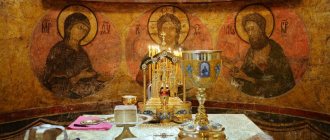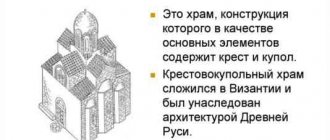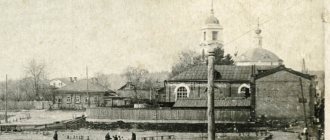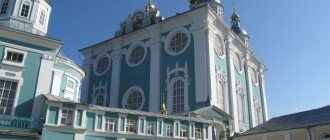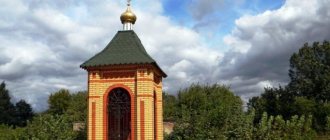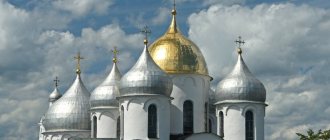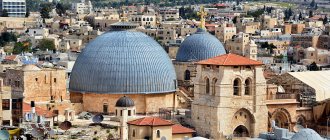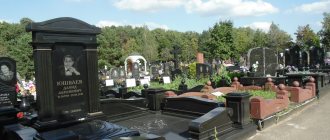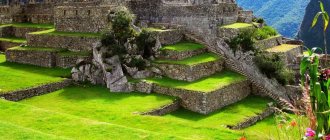Architectural features of temple buildings
The temple is a metaphorical image of Noah's Ark, which was built to save humanity from terrible destruction. Since the birth of Christianity, churches have been built for the laity so that they can save their souls from sin. Almost every day great Sacraments, divine services or holiday services are held in churches, and any baptized person can take part in the sacred rite.
External structure of an Orthodox church
Traditionally, temple buildings are built with the main gate to the west and the altar to the east. This arrangement symbolizes the divine path from darkness to light, along which God leads every believer in Him. In addition, the newly erected cathedral is consecrated and named after some saint or in honor of an Orthodox festival (Pokrovsky, St. Isaac's, Vladimir, etc.).
Temple forms
There are four types of buildings in temple architecture:
- cruciform - symbolizes the Cross on which Jesus Christ was crucified, saving all humanity by His sacrifice;
- rectangular - is an allegory of Noah’s Ark, as a symbol of salvation;
- round - marks the infinity of the Orthodox Church;
- eight-pointed - means the Star of Bethlehem, lit in the sky on Christmas night.
Today, almost all cathedrals are built in the shape of a rectangle or a cross, but earlier architects actively built churches according to other geometric designs.
Temple dome
A mandatory architectural element of all Orthodox churches is a dome topped with a cross. The number of goals is always odd and can reach thirteen units:
- one means the unity of the Lord;
- three are a sign of the Holy Trinity;
- five - signify the Savior and the four apostles who wrote the Gospel;
- seven - according to the number of main church Sacraments;
- thirteen - symbolize Jesus Christ and His twelve disciples.
Types of church domes
Church bells
The structure of any Orthodox cathedral is not complete without bells. They are the ones who notify the laity about the most important events in church life. The belfry, as a rule, is erected above the main entrance or next to the temple building. By the nature of the bell ringing you can determine its meaning:
- blagovest - a slow, measured ringing, calling for great holidays or solemn services;
- trezvon - ringing of all the bells, as a symbol of joy from the Orthodox festival;
- chime - an alternating ringing, signifying a funeral service.
In ancient times, there was another type of bell ringing - the alarm, which notified residents of a city or village of impending danger.
Cross on the temple
No matter how many chapters there are on the cathedral, they are all crowned with Orthodox crosses. The latter come in several types:
- quadrangular - a vertical beam is crossed at a right angle by a horizontal one;
- hexagonal - similar to the previous one, but below there is another, inclined beam with a raised left end;
- the eight-pointed one is the same hexagonal cross, but above the horizontal beam there is a small tablet with the engraved words: “Jesus of Nazareth, King of the Jews.”
Where did Jesus go?
The way home is easier than to the capital: you no longer need to carry cages with pigeons, lead calves, oxen, sheep and goats. The sacrifices were made, the men prayed in the Jerusalem Temple, they appeased God, and took away their sins.
And the son of this beautiful woman also prayed along with the adults. Maria smiled: how time flies! Now He is already an adult! When he was little, She also took Him with her to Jerusalem for the holiday, so as not to leave the baby alone for so many days. But He was already twelve! Now the son, like all men in Israel, must follow the strict rules of Jewish life and must himself appear in Jerusalem three times a year to worship God. This Easter, Mary’s son was for the first time allowed into the courtyard of the temple, where only adult men pray - even Her, the mother, is prohibited from entering there!
Perhaps I should ask Him how everything went there, otherwise I didn’t see the boy all day on the way. He must have been walking somewhere nearby, along with older men. The crowd is big, you can’t keep track of it... But now it’s time for my son to appear. Where is He?.. The mother looked around in confusion.
- Joseph, have you seen Jesus? - she asked her husband.
- No. I thought He was going with you...
- And I thought - with you, with the men... Maybe I should ask the neighbors?.. Have you seen our Jesus?
- No, we haven’t. But... so many people, such a crowd! It's easy to get lost. Don't worry, you will find it! Ask further...
-Have you seen our son?.. Jesus! Son, where are you?...
- What's happened?
— The carpenter Joseph and his wife Mary lost their son. Lost!
- Oh, trouble!.. Wait, Jesus? This is such a... smart, hard-working young man? Yes, we remember Him, we saw Him in Nazareth. And today on the way we didn’t meet...
The unfortunate parents did not sleep a wink all night. They went from fire to fire, from family to family, but no one could help them. The boy is missing. Maybe He overtook his parents and spent the night somewhere ahead?.. But Jesus is not that old yet... What if something happened to Him? Robbers attacked!.. or wild animals!..
Mary cried, Joseph consoled her: “Nothing, He must have gotten lost in the city. Let's go back and find...” When dawn broke, Joseph and Mary again took to the road and moved towards a huge stream of people, carts, camels and horses back to the high walls of Jerusalem.
Description of the internal structure of the temple
The plan of the modern Orthodox cathedral is based on the Old Testament canons of temple architecture. Today's church has the appearance of an ancient tabernacle and is similarly divided into three main components: the vestibule, the middle part, and the altar.
Narthex
It is located in the west and represents the vestibule of the middle part of the temple. In front of the entrance there is a small hill called the porch. Previously, catechumens stood here, since they were not allowed to enter the church before being baptized. Later, the porch began to be used for some divine services: litia, betrothal, announcement, cleansing of women in childbirth.
Interior of a Christian home
Main or middle part
This is the interior of the temple, where all the parishioners are and the main sacred ceremonies are held. It is divided into several zones, each of which has its own meaning.
Solea
It is a low step in front of the iconostasis, on which the priest stands during the service. The solea is designed to ensure that worshipers can be clearly seen even from the far end of the temple. It was especially significant in ancient times, when churches were poorly lit and were too cramped for parishioners to see priests reading prayers.
Pulpit
It is a continuation of the salt and has a rounded, slightly elongated shape. The pulpit is located in front of the Royal Doors, right in the center of the iconostasis. On this elevation, the priest delivers sermons, reads petitions, and reads Holy Scripture. On the sides of the pulpit there are small steps along which you can climb to the iconostasis.
Choir
The church choir and readers are located here during services. If the temple is large, there may be several choirs. They are usually built where the solea ends, on either side of the entrance to the altar. Each choir has its own choir, but during daily services the singers sing from one place.
Story
The very first temple is considered to be the upper room where the Last Supper . On it Christ established the Sacrament of the Eucharist. Then the first Christians chose clean, spacious premises for churches. Later, during the persecution of Christians, they had to pray in hidden places. They were located in dungeons and were called catacombs. These places of prayer have still been preserved, for example in Rome.
Then they began to build temples facing east. About thirty churches appeared in Rome between the persecutions. At first, the priests stood facing the people and prayed like this, seeing in everyone present the image of God Himself. But then, in order to avoid temptations, they began to turn their faces to the east. The first altars and iconostases appeared.
A special surge in the construction of churches occurred during the time of Saints Constantine and Helena . Among them is the Church of the Holy Sepulcher. Former pagan temples or administrative buildings (basilicas) were converted into Christian churches. They were rectangular in shape. Gradually, extensions for the altar and vestibules began to appear.
Unusual temple
Let’s leave Mary and Joseph to look for their son for now and ask what seems like a simple question. Why did they and other residents of Nazareth go to Jerusalem? - So how! It was said: for Easter, for the holiday, to the Jerusalem temple! - That's right, but why go so far? Didn't Nazareth have its own temple?
Well, actually, there were a lot of temples in those days when Judea was under the rule of the Roman Empire. True, these were temples of different gods. The Romans and Greeks had not even dozens, but hundreds of gods. There was a god of trade, a god of lightning, a goddess of hunting, a goddess of wisdom, a god and goddess of beauty, there was even a god of winemaking and a goddess of clouds! These gods lived noisily, quarreled and made peace with each other, lured away each other's fans, took revenge on each other, attracting people to help, and then betrayed these same people, feasted and fought... In general, they behaved like ordinary people. And they built temples almost like ordinary people: if I like God, I’ll build him a temple; if I don’t like it, I’ll break it and build it for someone else. And people’s relationships with the gods were like in a bazaar: I am a sacrifice to you, you are a fulfillment of a desire to me. And just try and don’t do it: I’ll complain to the other gods, they’ll show you!..
The only people on earth who, at the time of Jesus, worshiped the One God, God the Creator of all things, the whole world - visible and invisible, was the Jewish people. And only the Jews had a temple dedicated to this God. The only temple that looked completely different from the Orthodox churches we are used to. Moreover, he looked completely different from how Christian icon painters depicted him on icons.
The history of the Jerusalem Temple was amazing!
A very, very long time ago, almost three and a half thousand years ago, the Jewish people languished in captivity under the Egyptian pharaoh. But the prophet Moses was able to lead the Jews out of Egyptian captivity, save them from slavery and hide them in the desert.
Thousands of people camped at Mount Sinai. Moses climbed to Sinai, where the Lord revealed himself to him and gave the Ten Commandments - the Covenant. Moses inscribed the commandments on stone tablets. The Jews put these tables in a special box, an ark, which they made as God told them. God also ordered the construction of a sacred tabernacle - a tent in which the Ark of the Covenant would be kept. The tabernacle was surrounded by a fence, and this temporary temple became the place of worship of the ancient Jews. In addition to the Ark of the Covenant, other objects sacred to the Jews were kept in the tabernacle: a vessel with manna from heaven - wonderful food, bread that fell from the sky, preventing Jews from dying of hunger in the desert. And the rod of Aaron, the brother of Moses, the first priest of the Jews, was kept there.
Tabernacle of Moses The very first portable temple of Israel. Here, in the Ark of the Covenant (1), stone tables with the ten commandments that God gave to Moses were kept - the Tablets of the Covenant (2) . And here was also the blossoming rod of the first priest Aaron (3) and manna (4) - the wonderful food that God sent to the Jews in the desert.
When the Jews prayed in the tabernacle and made sacrifices to God, a pillar of fire descended onto the tabernacle, the same as the one that moved before the Jewish people, showing the way from Egypt. This is how God showed that He was nearby.
Why did the Jews need to sacrifice animals? It was believed that it was possible to atone for any sin and receive forgiveness from God only by making a sacrifice. Although the ancient prophets and righteous people already in ancient times said that the real sacrifice to God is not calves, lambs, kids and doves, whose carcasses were burned on altars, but the reconstruction of one’s own life. God wants you to live in accordance with His Divine plan for you - then you will please Him! But in ancient times, people had not yet matured to such a high understanding of the relationship with God, therefore, due to their weakness, God allowed them to sacrifice animals, although He did not need it at all.
The Jews spent many years in the desert in wanderings and hardships and finally came to the Holy Land, the Promised Land, the Land of Israel. Pagan tribes lived here then. The Jews began to develop these regions. In their first capital, they erected a new tabernacle for the Ark of the Covenant and built stone walls around it. It served the Jews as a temple for three hundred years, until the appearance of the great Israeli king David.
David began to build the city of Jerusalem. And I thought about building the first temple. For what? David probably reasoned like this: “When my people had tents and tents, God also had a temporary tent. Now my people have built strong houses for themselves. Why should God dwell in a tent? We need to build Him a worthy place where God can dwell and people can glorify Him!”
David began clearing the site on the mountain. He had already drawn up a construction plan, but did not have time to build the temple himself - he handed over the work to his son, another great and wise Israeli king, Solomon. King Solomon built the first Temple in Jerusalem!
Where was Jesus?
...The travelers Mary and Joseph were approaching the city, and the sun's rays, reflecting from the walls of the Jerusalem Temple, blinded their eyes.
Where is Jesus? The parents wandered around the city all day. They walked around all the bazaars, all the squares, looked at all the relatives and friends in Jerusalem - their son was nowhere to be found. Tired, they came to the temple. We went up the high steps and entered the “women’s courtyard,” where all Jews were allowed to come—men, women, and even children.
On both sides of the courtyard the stone galleries were crowded. The residents of Jerusalem loved to come here and spent whole days here - it’s shaded, it’s cool, you can sit and have leisurely intelligent conversations about the law, about taxes, about the coming Messiah...
Mary and Joseph saw the crowd from afar. It seems that some new preacher has gathered around him the most intelligent and respected scribes. I wonder who it is? Mary and Joseph looked at each other: perhaps it’s worth approaching and asking if anyone from those gathered knows something about their son, where to look for him...
They came closer and... were dumbfounded! The gray-haired, wise elders listened to the twelve-year-old boy! Their Jesus! They shook their heads, squinted, smiled, looked at each other, rubbed their beards and sides with their palms, raised their eyebrows... And He, as if nothing had happened, sat in the center of the crowded people, telling them something, asking questions that clearly puzzled many, but He himself answered and explained them...
Maria stepped forward. Jesus noticed Her and rose to meet her.
- Child! What have you done to us? Behold, Your father and I have been looking for You with great sorrow!
- Why did you need to look for Me? — the boy answered calmly. “Or didn’t you know that I should be in what belongs to My Father?”
Mary and Joseph looked at each other. Joseph shrugged. They did not understand the words of the Son. They did not understand that now Jesus was not in the carpenter’s house in Nazareth, where His relatives were accustomed to seeing Him, but where He should be - in the house of His Father, God. Son of God Jesus Christ.
Jesus approached Mother and Joseph and left the temple with them. The family arrived safely in Nazareth, and ordinary days began to flow. Jesus grew up, matured, learned carpentry, helped Joseph...
Eighteen years will pass, and the thirty-year-old Christ will come out to preach the Word of God. He will come to the Jerusalem temple and teach and preach there. Jesus will recruit disciples for himself, and when they come to the Jerusalem Temple and are surprised at how majestic and beautiful these walls and stones are, Christ will predict that soon there will not be left one stone upon another here, everything will be destroyed. Then one of the disciples will betray Jesus, and the judges will accuse Christ of wanting to destroy the Temple of Jerusalem... Jesus will be led to Golgotha, and, accepting death on the Cross, the Savior will see smoke rising from the altars of this temple. While the priests were making sacrifices in the temple courtyard, Christ sacrificed Himself for the sake of all people.


